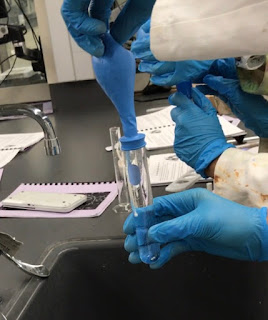Lab 3: Chromatography Lab
Chromatography Lab
Introduction:
The purpose of this lab was to separate the pigments from a black pen/marker marking using a cup, water and filter paper. The important terms for this lab include pigments and chromatography. A pigment is basically just the color of a substance of object. Chromatography is the process of separating components or in this case pigments from a mixture.
Questions:
1. Why is it important that only the wick and not the filter paper circle be in contact with the water in the cup?
It is important that only the wick touches the water and not the filter paper because the water must be distributed evenly on the paper and if it is in contact on somewhere other than the wick, then the pigment bands will be skewed.
2. What are some of the variables that will affect the pattern of colors produced on the filter paper?
Some of the variables that will affect the pattern of colors produced on the filter paper are, the amount of ink used/thickness, shape of pen marks, pigments/colors in the ink, and distance between marks.
3. Why does ink separate into different pigment bands?
The ink separates into different pigment bands because each pigment has different physical properties so some of them will not be absorbed as quickly as others. This means that the ones that are absorbed faster than others will more a shorter distance than those who are a absorbed slower.
4. Choose one color that is present in more than one type of ink. Is the pigment that gives this color always the same? Do any of the pens appear to contain common pigments? Explain.
I chose the color blue because most of my tests had some shade of blue. No, the pigment that gives the color blue is not always the same because each one has slightly different shades; however, they are similar because they are only different shades and they show up around the same area on each test which is near the outside. Yes, the pens do appear to contain common pigments because black consists of similar pigments. They aren't exactly the same but since each pen is black they will have some common pigments like blue, pink and hints of yellow.
5. Why are only water-soluble markers or pens used in this activity? How could the experiment be modified to separate the pigments in "permanent" markers or pens?
Water-soluble markers or pens were used in this activity because we were using water as a solvent to dissolve the pigments. This obviously means that we needed to use a water-soluble marker or pen so it would dissolve. If the experiment was changed to separate the pigments in "permanent" markers or pens, we would need a solvent that dissolves its pigments. An example that would maybe work for this experiment would be rubbing alcohol.
Conclusion:
Overall, this experiment was a success because in the end, clear results were made, and the pigments were distributed over the paper. Although, it took a few tries to get a good result, we still completed the purpose of the lab.




Comments
Post a Comment